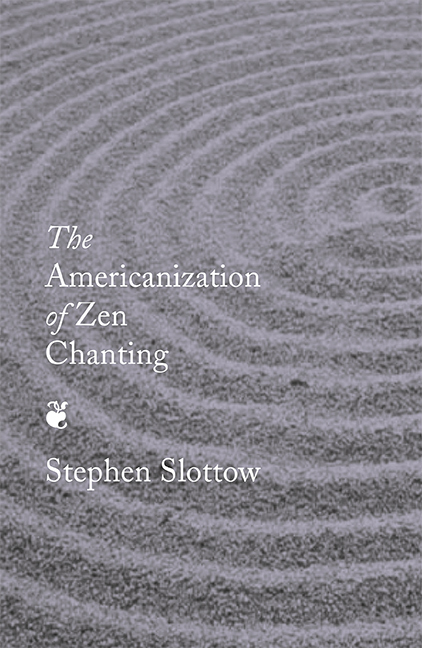Book contents
- Frontmatter
- Contents
- List of Examples
- Acknowledgements
- Chapter 1 Introduction
- Chapter 2 Purposes and Functions of Zen Chanting
- Chapter 3 Performance Practice
- Chapter 4 Typology, Translation, and Ceremonies
- Chapter 5 Conclusion
- Bibliography
- Discography and Videography
- Appendix: Alternative Chant Names
- Index
Chapter 2 - Purposes and Functions of Zen Chanting
- Frontmatter
- Contents
- List of Examples
- Acknowledgements
- Chapter 1 Introduction
- Chapter 2 Purposes and Functions of Zen Chanting
- Chapter 3 Performance Practice
- Chapter 4 Typology, Translation, and Ceremonies
- Chapter 5 Conclusion
- Bibliography
- Discography and Videography
- Appendix: Alternative Chant Names
- Index
Summary
Chanting is part of the repertoire of Zen practice in almost every North American and Japanese training center or temple. A few centers, however, even in Japan, have dispensed with it, at least in part. At Antaiji, a Soto temple originally located in Northern Kyoto, the style of sesshin inaugurated by Kosho Uchiyama in 1965 has been characterized as “Zen without toys”: no ceremonies, teisho, samu (work practice), kyosaku (“encouragement” stick), bathing, or chanting (Okamura 2012, xi). Uchiyama was the principle successor of Kodo Sawaki (“homeless Kodo”) (Braverman 2003, 8; Uchiyama 2014), and this sesshin style has been continued by other teachers in Uchiyama's line, such as the present Antaiji abbot, Muhō Nölke, and Shohaku Okumura, who currently teaches at Sanshin-ji, Bloomington, Indiana.
An American center that does not incorporate chanting is the Springwater Center, in Springwater, New York, founded by Toni Packer in 1981 and continued by her students after her death in 2013. A senior student and prospective dharma heir of Philip Kapleau, in 1981 she left the Rochester Zen Center, where she had assumed teaching responsibilities, after she decided that she did not consider herself a Buddhist and could not in good conscience teach within a Buddhist context. The successive names of her Center chronicle her increasing disassociation with Zen Buddhism: at first the Genesee Valley Zen Center, then the Springwater Center for Meditative Inquiry, and finally just the Springwater Center (Ford 2006, 160-62). Unlike Antaiji, where chanting is viewed as a “toy” which distracts from the exclusive centrality of formal seated zazen, at Springwater chanting is considered part of a traditional Zen Buddhist practice style with which the Center has long since ceased to identify.
These exceptions aside, virtually all North American Zen Centers and teachers incorporate some amount of chanting. But why? One reason, of course, is that chanting was part of their training, whether in North America or Japan. But why was it part of their training? What is the role of chanting in Zen practice? And why do American Zen teachers choose to continue the practice? There is a wide range of answers to those questions. They aren't mutually exclusive, however, but point to different and often complementary aspects of chanting as an aspect of Zen training.
- Type
- Chapter
- Information
- The Americanization of Zen Chanting , pp. 7 - 36Publisher: Boydell & BrewerPrint publication year: 2018



